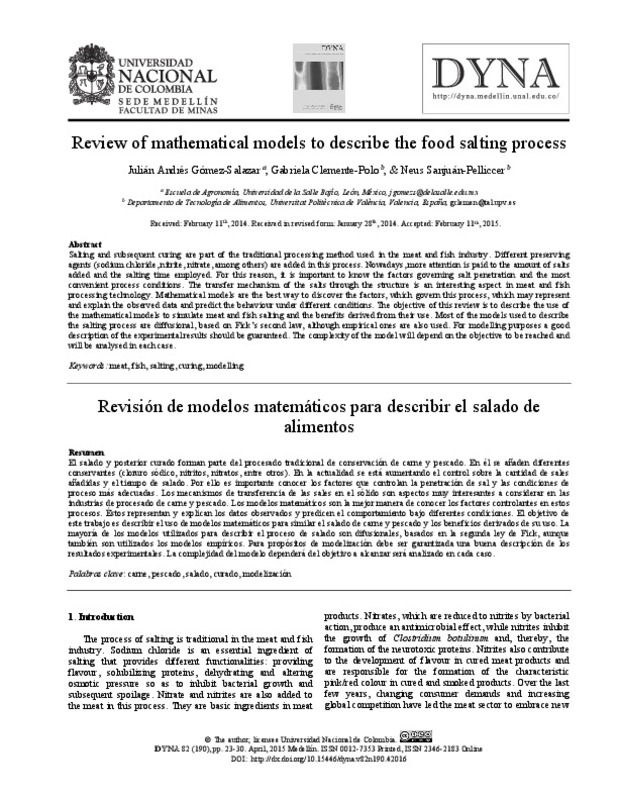|
Resumen:
|
[EN] Salting and subsequent curing are part of the traditional processing method used in the meat and fish industry. Different preserving
agents (sodium chloride, nitrite, nitrate, among others) are added in this process. ...[+]
[EN] Salting and subsequent curing are part of the traditional processing method used in the meat and fish industry. Different preserving
agents (sodium chloride, nitrite, nitrate, among others) are added in this process. Nowadays, more attention is paid to the amount of salts
added and the salting time employed. For this reason, it is important to know the factors governing salt penetration and the most
convenient process conditions. The transfer mechanism of the salts through the structure is an interesting aspect in meat and fish
processing technology. Mathematical models are the best way to discover the factors, which govern this process, which may represent
and explain the observed data and predict the behaviour under different conditions. The objective of this review is to describe the use of
the mathematical models to simulate meat and fish salting and the benefits derived from their use. Most of the models used to describe
the salting process are diffusional, based on Fick s second law, although empirical ones are also used. For modelling purposes a good
description of the experimental results should be guaranteed. The complexity of the model will depend on the objective to be reached and
will be analysed in each case.
[-]
[ES] El salado y posterior curado forman parte del procesado tradicional de conservación de carne y pescado. En él se añaden diferentes
conservantes (cloruro sódico, nitritos, nitratos, entre otros). En la actualidad se ...[+]
[ES] El salado y posterior curado forman parte del procesado tradicional de conservación de carne y pescado. En él se añaden diferentes
conservantes (cloruro sódico, nitritos, nitratos, entre otros). En la actualidad se está aumentando el control sobre la cantidad de sales
añadidas y el tiempo de salado. Por ello es importante conocer los factores que controlan la penetración de sal y las condiciones de
proceso más adecuadas. Los mecanismos de transferencia de las sales en el sólido son aspectos muy interesantes a considerar en las
industrias de procesado de carne y pescado. Los modelos matemáticos son la mejor manera de conocer los factores controlantes en estos
procesos. Éstos representan y explican los datos observados y predicen el comportamiento bajo diferentes condiciones. El objetivo de
este trabajo es describir el uso de modelos matemáticos para similar el salado de carne y pescado y los beneficios derivados de su uso. La
mayoría de los modelos utilizados para describir el proceso de salado son difusionales, basados en la segunda ley de Fick, aunque
también son utilizados los modelos empíricos. Para propósitos de modelización debe ser garantizada una buena descripción de los
resultados experimentales. La complejidad del modelo dependerá del objetivo a alcanzar será analizado en cada caso
[-]
|









